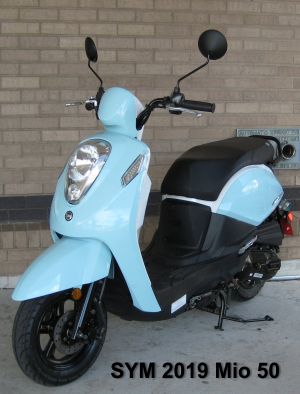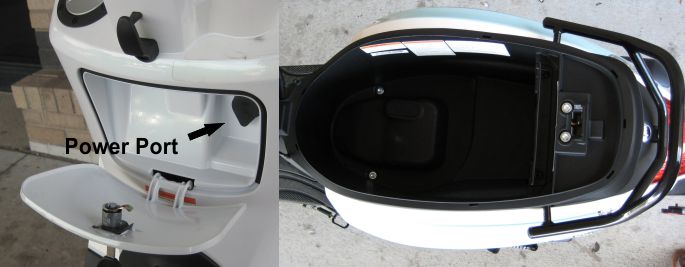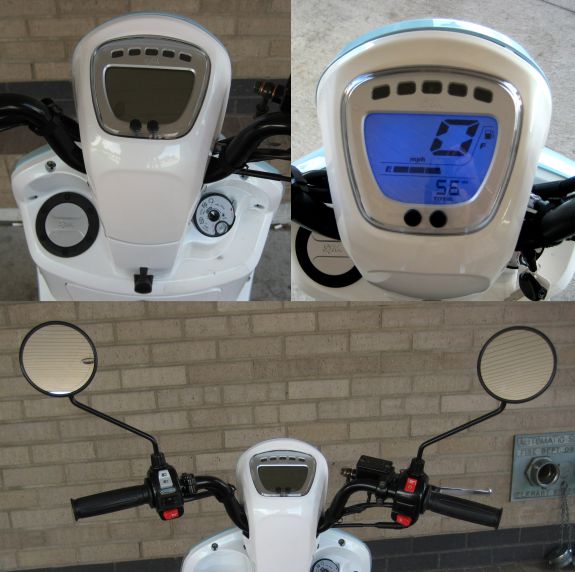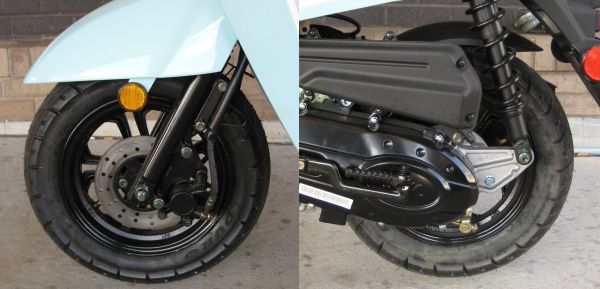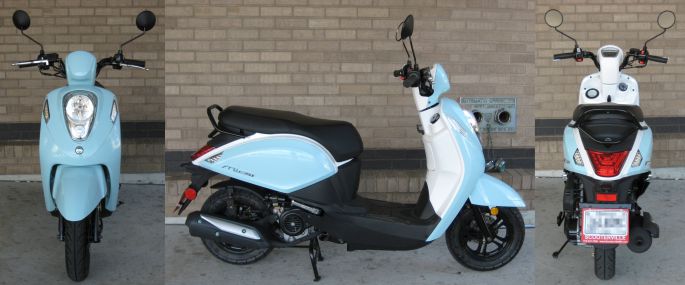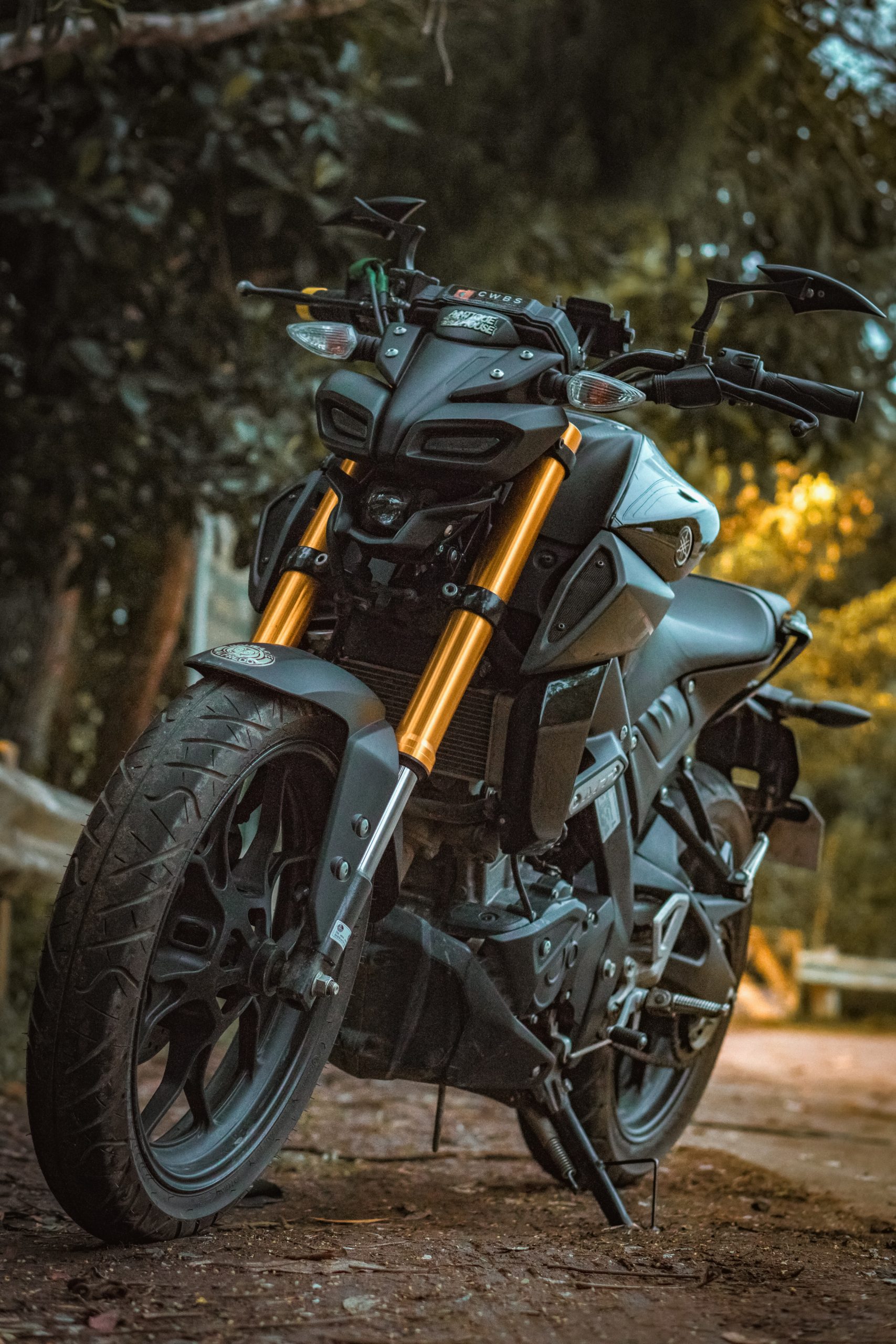August 2019 – Wow. It has been eleven years since I first reviewed the Minnesota moped-legal SYM Mio scooter. Since 2008, the Mio has been my recommendation for a four-stroke moped-legal scooter. Apparently the team at Alliance Powersports (the USA distributor for SYM) pay more attention to this website than I do because they contacted me and asked if I’d like to have a look at the new Mio. Alliance has done a great job with SYM since the Carter Brothers debacle and I was curious to see what had changed on this cute, fun machine. Good ol’ Scooterville in Minneapolis came through with a unit for me to have for a few days.
There have been changes since 2008, in scooters and for me. My wife and I now live in a northeastern suburb of the Twin Cities with no road 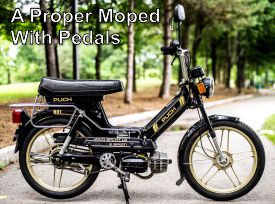
For those of you who haven’t read most of my other scooter blatherings (you know who you are… the smart ones) let’s go over this whole “moped-legal” thing briefly. Mopeds used to be those funky half bicycle things that had pedals AND an engine. With some of them, one pedaled to get the moped going and then engaged the engine to cruise without pedaling. These have virtually vanished from the USA market and now we have “mopeds” that are, in fact, really just moped-legal scooters. In Minnesota, that means a 50cc or smaller engine, two horsepower and a maximum speed of 30MPH. One can operate a moped-legal scooter with just an ordinary driver’s license, no need for a motorcycle endorsement. One can also legally park a moped-legal scooter in most bike racks. On some school campuses, moped parking is far and away the most inexpensive (generally free) and available vehicle storage methodology. These advantages have continued to drive moped-legal scooter popularity. Not all 50cc scooters are moped-legal in Minnesota. At the time of this writing, the 50cc scooters from Honda, Yamaha 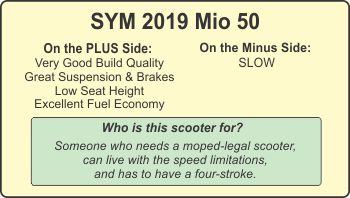
SYM (San Yang Motors) is based in Taiwan and has been around since 1961. Over the years SYM has brought us some excellent scooters and motorcycles and they are one of the brands I routinely recommend to people looking for a quality machine. SYM distribution and support in the USA had been spotty in the past, but since 2011 Alliance Powersports has done a fine job of supporting and growing the SYM lines here. The older model Mio earned my hearty endorsement for a four stroke moped-legal scooter. The new model is still my pick, albeit with reservations.
Speedometer Reading/Speed/Fuel Economy
There were several aspects of the new Mio that had my curiosity piqued before I started the review process. The previous version of the Mio 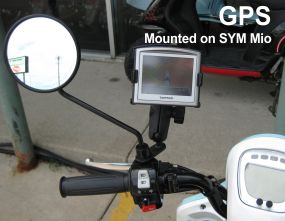
Like most scooters, the Mio was optimistic in its speed and mileage displays. At an indicated 30MPH, the actual speed fluctuated from 26MPH to 27MPH. On an actual ride of 10.1 miles the odometer indicated 11 miles. 10% optimistic is not at all out of the ordinary, but I was hoping for better. As alluded to previously, there is less of me for these poor scooters to haul around these days but the most I could get out of the Mio was 36MPH. I might have seen some flickers of 37MPH on the GPS, but I couldn’t hold that. As I’ll cover further in the “Riding Impressions” section, it took a long time to get to that speed.
Fuel economy was wonderful. A true 100 Miles-Per-Gallon and maybe even a touch more. And that was on a new scooter, not broken in and with me running pretty hard on the throttle. As much as I bash four stroke 50cc scooters, I have to acknowledge how frugal they are with fuel.
Features
I have to admit I had a tough time deciding what models to include in this comparison chart. Should it be just moped-legal? Should it be four strokes AND two strokes? I decided to stick to four stroke versions and compare the Mio with the Honda Metropolitan which is NOT moped-legal in Minnesota and the Kymco Like 50i.
The Honda Metropolitan is the scooter most often compared with the SYM Mio. They are very similar in looks and size. Of course “Honda” is a much better known brand and has a well-deserved reputation for high quality. The Metro is just slightly smaller than the Mio, weighing a touch less and having a slightly lower seat. 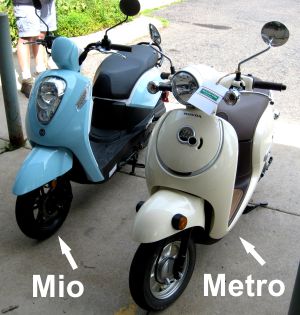
The SYM Mio has an air-cooled, carburetor fed, ceramic-coated cylinder 50cc engine. The engine on the previous version of the Mio was a real sweetheart. I expect this engine will prove to be good running and reliable but it doesn’t seem to have the power potential of the previous one. Power gets to the rear wheel via an automatic CVT (Continuously Variable Transmission).
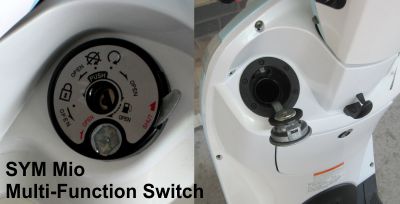
The dash is clean and simple with a row of indicator lights across the top and a center pod with fuel gauge, digital speedometer and odometer. Even with pretty bright sunlight everything was easy to see and read. The mirrors are well placed and give a decent rearward view 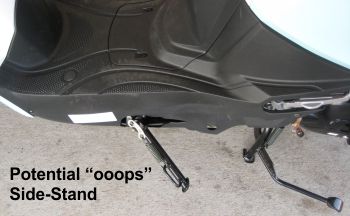
Riding Impressions
Low seat height, light weight and quality components combine to make the Mio easy and un-intimidating for just about anyone to ride. The Mio was just a touch cold-blooded and needed a minute of warm up in the morning to run and idle smoothly. The Mio is light overall and has a low center of gravity. The (relatively) short wheelbase and smallish wheels combine with that lightness to give the Mio very quick and responsive handling. The suspension gave good feedback and was firm enough to feel secure without making the ride feel rough. I felt large road hazards but smaller bumps barely got through. The Honda Metropolitan that I rode was soft to the point of feeling mushy in comparison. Brakes was more than strong enough for a scooter of this size. Effort at the levers was a little higher than some comparable scooters but I prefer that to “grabby” feeling brakes. All the switches and controls worked flawlessly and felt like the high quality components they likely are.
So far, the new Mio compares quite favourably with the previous one – quality, suspension, brakes, all very good. Now we have acceleration and speed. Or, rather, we don’t. The SYM Mio is certainly NOT the worst performing four stroke 50cc scooter I have ridden, but it is nothing like as peppy as its predecessor. It is slow off the line, has a lesser top speed and takes a while to get there. Roll on acceleration is not there. If one is cruising along at 30MPH and has to slow for traffic it will take some time to get back up to cruising speed. So is it unrideable? Nope, I have been on slower. The great ride and handling are still there, one just has to adjust one’s expectations to the reality of the powerplant.
Fit and Finish
I have been spending time with SYM scooters for more than ten years now and they continue to impress me with quality that appears to be the equal of any scooter in the marketplace. Even head to head with a Honda Metropolitan of the same vintage the Mio has some components that are better (the wheels for instance). The fit of the panels is quite good and even digging deeper one sees care in manufacturing and assembly that is lacking in other scooters. The CVT cover fit and alignment to the powertrain case is excellent, gaps in plastic panels that sit side by side is uniform and paint coverage is uniform. The SYM Mio certainly seems to be continuing the SYM tradition of high quality.
Conclusion
Here in Minnesota, the whole moped-legal thing creates a market segment that forces some compromises. Scooters like the SYM Mio are purchased by people who:
Want to ride legally but don’t want to get a motorcycle endorsement
Need the many parking advantages offered by a moped-legal scooter
Have no need or desire to ride on highways
Want the ease of use and simplicity of operation of a 50cc automatic scooter
Want exceptional fuel economy and low operating costs
Are drawn to the small physical size
Of course there are also the more subjective elements such as the look and even the fun of scooters. As of this writing, one is quite limited in choices so far as EPA approved two stroke moped-legal scooters and, frankly, they are not going to be available forever. Two stroke scooters are not as clean running or as fuel efficient as four stroke scooters. If the SYM Mio fits you and your riding style go out and get one. You will likely be enjoying it for many years to come.
David Harrington

